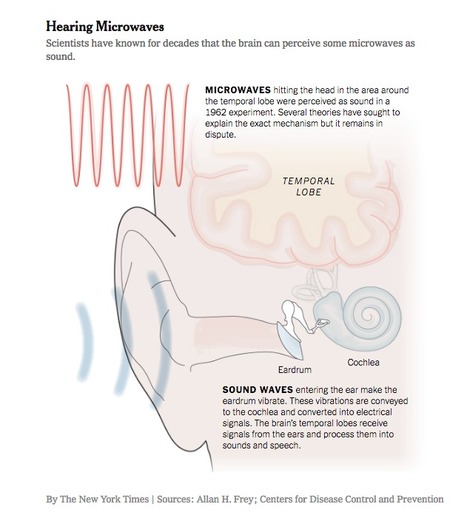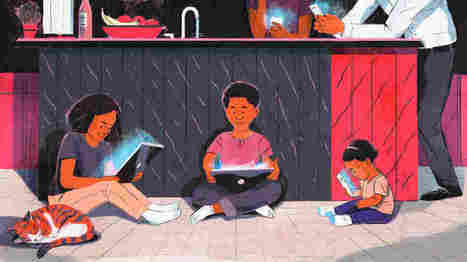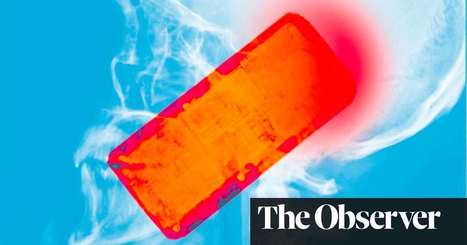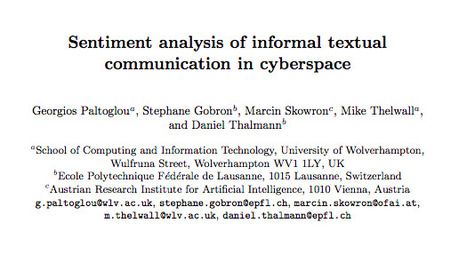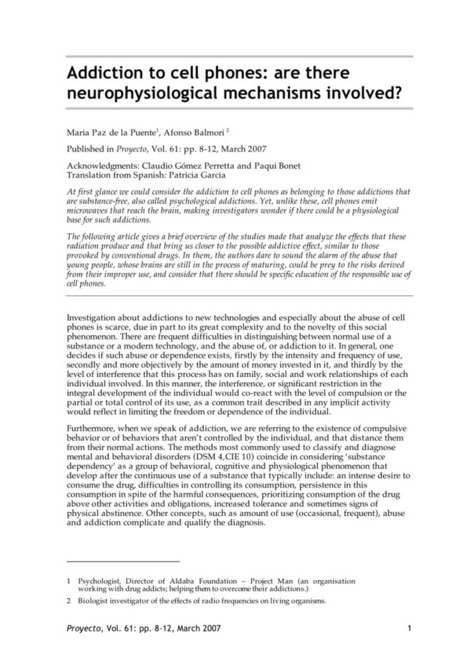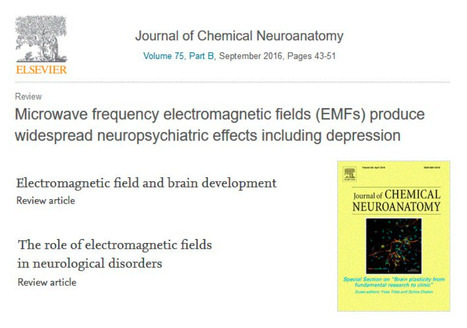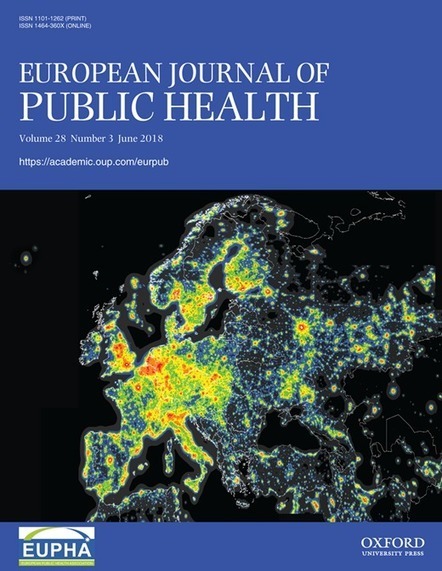 Your new post is loading...
 Your new post is loading...

|
Scooped by
Roxana Marachi, PhD
December 3, 2018 9:01 PM
|
By Nicole Karlis "Mobile giant Samsung and telecom company Verizon made a joint announcement on Monday that was supposed to be unequivocally exciting news: the blazing-fast fifth generation wireless cellular network — known as 5G — is slated to be more accessible in the United States in the first half of next year. Yet public health experts, professors, and watchdog groups are increasingly concerned about the untested aspects that this next-gen cell network requires — including more cell towers and a constant chorus of higher-energy photons streaming through human bodies and dwellings. It's a bit of a David and Goliath battle, as Big Telecom's PR and marketing teams have been busy hyping the possibilities of 5G, while watchdog groups struggle to get funding for even meager studies into potential health effects."... For full post, see:
By Andrew Crocker and Jennifer Lynch, June 22nd, 2018 "The Supreme Court handed down a landmark opinion today in Carpenter v. United States, ruling 5-4 that the Fourth Amendment protects cell phone location information. In an opinion by Chief Justice Roberts, the Court recognized that location information, collected by cell providers like Sprint, AT&T, and Verizon, creates a “detailed chronicle of a person’s physical presence compiled every day, every moment over years.” As a result, police must now get a warrant before obtaining this data. This is a major victory. Cell phones are essential to modern life, but the way that cell phones operate—by constantly connecting to cell towers to exchange data—makes it possible for cell providers to collect information on everywhere that each phone—and by extension, each phone’s owner—has been for years in the past. As the Court noted, not only does access to this kind of information allow the government to achieve “near perfect surveillance, as if it had attached an ankle monitor to the phone’s user,” but, because phone companies collect it for every device, the “police need not even know in advance whether they want to follow a particular individual, or when.” For years, the government has argued that the sensitive nature of this data doesn’t matter; the mere fact that it’s collected by phone companies makes it automatically devoid of constitutional protection."... For full post, see: https://www.eff.org/deeplinks/2018/06/victory-supreme-court-says-fourth-amendment-applies-cell-phone-tracking
By John Warner "Normally it’s Joshua Kim’s IHE blogger beat to read a book and go looking for the education parallels, but after tearing through Bad Blood: Secrets and Lies in a Silicon Valley Startup by Wall St. Journal reporter John Carreyrou, I can’t resist infringing on his territory. Bad Blood is the story of Theranos, a blood testing company which once promised to be able to run hundreds of tests on its proprietary device using only a pinprick of blood, rather than relying on the far more voluminous (and scary to so many) venous draw. The public face of Theranos, founder and CEO Elizabeth Holmes in her Steve Jobs-emulating black turtleneck was a charismatic public presence, wooing support from eminences such as George Schultz, Henry Kissinger, Rupert Murdoch, Betsy DeVos, Bill, Hillary, and Chelsea Clinton, Barack Obama, and current defense secretary James Mattis, who declared of Holmes, “She has probably one of the most mature and well-honed sense of ethics — personal ethics, managerial ethics, business ethics, medical ethics that I’ve ever heard articulated.”[1] Holmes was feted in Fortune and Wired, and Walgreens and Safeway invested tens and hundreds of millions of dollars in Theranos. But Carreyrou reveals Holmes as a fraud. Through a combination of secrecy, lies, flattery, and intimidation, she maintained a fiction about having developed a truly revolutionary piece of technology which sounded like science-fiction, a desktop device that could diagnose disease. Even as Carreyrou was amassing a crushing amount of evidence which would expose the deceptions, Holmes used prominent attorney David Boies and his firm Boies Schiller to threaten Carreyrou and his sources with lawsuits and professional ruin.[2] The Theranos “Edison” was “vaporware.” It never existed as anything beyond a theoretical prototype. When Theranos did manage to deliver accurate test results, it used devices produced by other companies. Elizabeth Holmes was claiming to investors her device was saving lives on the battlefield of Afghanistan even as they couldn’t get it to accurately measure Vitamin D levels in the lab.[3]..." [concluding section]: "Ultimately it was people inside of Theranos who took the “first do no harm” message of the Hippocratic Oath seriously who helped blow the whistle on Holmes’ fraud. I’m thinking we should have a similar "first do no harm" threshold for introducing technology into the classroom. How much ed tech would pass that muster?"... For full post, see: https://www.insidehighered.com/blogs/just-visiting/theranos-story-and-education-technology

|
Scooped by
Roxana Marachi, PhD
November 30, 2018 11:11 AM
|
By Cindy Eckard
The schools' demands for ever more digital device use has parents worried, and for good reason. Many moms ask me, "How much screen time is safe for my child?" But focusing exclusively on the amount of screen time may not get to the heart of the matter, because it's just too complicated a health issue for a cookie-cutter solution. The best way to approach the problem is to have a complete examination of your own children's health and their specific requirements so you can protect them. That's a concrete determination from medical professionals that cannot be refuted by the schools. This means a full physical and a dilated eye exam (be sure to ask about dry eye disease, too - it's critical) and a full understanding of the kids' overall habits as they impact sleep, healthy weight, mental health, academic performance and overall healthy development. Are your children becoming nearsighted? Overweight? Having trouble sleeping? Depressed or anxious? Unable to stop using a device? These health issues are all directly associated with daily use of devices. Armed with data about your own children's health, you can ask for specific adjustments in the classroom, based on your doctors' perspective and your role as a parent. You can demand that your child's health is not negatively impacted and remind the teachers and school administration of their legal obligation to provide a safe learning environment (their "duty of care"). Next, ask for a full accounting of your own children's daily screen experiences at school and the schools' requirements for more screen use at home for studying. Determine if proper seating and lighting are employed in the classroom, per the manufacturers' safety warnings. This is where it gets very interesting. Is your school heeding manufacturers' safety warnings?
Few - if any - central offices actually share the manufacturers' safety warnings with the schools, the teachers, the students or the parents. There are hundreds of pages documenting the safe use of this equipment to avoid what HP and Dell (makers of Chromebooks, by the way) describe as "serious bodily harm." The makers of the equipment have already done all this homework; the school systems are just conveniently not sharing it - or heeding it. How many schools allow students to sit humped over screens, or balance the devices on their laps? Laptops were never intended to be used as full time workstations - they are ergonomically unsafe, and need to be mitigated with a monitor stand for proper height (adjustable, for growing children), an exterior keyboard and an exterior mouse.
Here are some links and details to share with your school. Request that their digital devices are used in a safe manner - which means employing the manufacturers' guidelines for health and safety:"... For post on main website, see: http://www.screensandkids.us/2018/11/worried-about-classroom-screen-time-ask.html

|
Scooped by
Roxana Marachi, PhD
November 20, 2018 1:58 AM
|
By Dr. Ron Melnick "A recent study by the National Toxicology Program/National Institutes of Health (NTP/NIH) shows clear evidence of a causal link between cancer and exposure to wireless cell phone signals. Results from the $30 million NTP studies demonstrated that cell phone radiation caused Schwann cell cancers of the heart and brain gliomas in rats, as well as DNA damage in the brain.
In NIH’s news release, NTP senior scientist John Bucher said, “We believe that the link between radio frequency radiation and tumors in male rats is real and the external experts agreed.”... https://thehill.com/opinion/healthcare/416515-theres-a-clear-cell-phone-cancer-link-but-fda-is-downplaying-it

|
Scooped by
Roxana Marachi, PhD
May 5, 2019 1:52 PM
|
'The future of wireless technology holds the promise of total connectivity. But it will also be especially susceptible to cyberattacks and surveillance. ' By Sue Alpern "In January, 2018, Robert Spalding, the senior director for strategic planning at the National Security Council, was in his office at the Eisenhower Executive Office Building, across the street from the White House, when he saw a breaking-news alert on the Axios Web site. “Scoop,” the headline read, “Trump Team Considers Nationalizing 5G Network.” At the time, Spalding, a brigadier general in the Air Force who previously served as a defense attaché in Beijing, had been in the military for nearly three decades. At the N.S.C., he was studying ways to insure that the next generation of Internet connectivity, what is commonly referred to as 5G, can be made secure from cyberattacks. “I wasn’t looking at this from a policy perspective,” he said. “It was about the physics, about what was possible.” To Spalding’s surprise, the Axios story was based on a leaked early draft of a report he’d been working on for the better part of a year. Two words explain the difference between our current wireless networks and 5G: speed and latency. 5G—if you believe the hype—is expected to be up to a hundred times faster. (A two-hour movie could be downloaded in less than four seconds.) That speed will reduce, and possibly eliminate, the delay—the latency—between instructing a computer to perform a command and its execution. This, again, if you believe the hype, will lead to a whole new Internet of Things, where everything from toasters to dog collars to dialysis pumps to running shoes will be connected. Remote robotic surgery will be routine, the military will develop hypersonic weapons, and autonomous vehicles will cruise safely along smart highways. The claims are extravagant, and the stakes are high. One estimate projects that 5G will pump twelve trillion dollars into the global economy by 2035, and add twenty-two million new jobs in the United States alone. This 5G world, we are told, will usher in a fourth industrial revolution. A totally connected world will also be especially susceptible to cyberattacks. Even before the introduction of 5G networks, hackers have breached the control center of a municipal dam system, stopped an Internet-connected car as it travelled down an interstate, and sabotaged home appliances. Ransomware, malware, crypto-jacking, identity theft, and data breaches have become so common that more Americans are afraid of cybercrime than they are of becoming a victim of violent crime. Adding more devices to the online universe is destined to create more opportunities for disruption. “5G is not just for refrigerators,” Spalding said. “It’s farm implements, it’s airplanes, it’s all kinds of different things that can actually kill people or that allow someone to reach into the network and direct those things to do what they want them to do. It’s a completely different threat that we’ve never experienced before.”... https://www.newyorker.com/news/annals-of-communications/the-terrifying-potential-of-the-5g-network

|
Scooped by
Roxana Marachi, PhD
November 11, 2018 8:17 PM
|
Abstract: During 26-28 March 2018, the National Institute of Environmental Health Sciences (NIEHS) National Toxicology Program (NTP), a part of the U.S. National Institutes of Health, convened a three-day technical reports peer-review panel meeting in Research Triangle Park, North Carolina, to review the NTP's draft reports on its carcinogenesis studies of cell-phone RF radiation in mice and rats. https://ieeexplore.ieee.org/document/8425056/references#references

|
Scooped by
Roxana Marachi, PhD
September 23, 2018 2:28 AM
|
"We recommend a moratorium on the roll-out of the fifth generation 5g, for telecommunication until potential hazards for human health and the environment have been fully investigated by scientists independent from industry... RF-EMF has been proven to be harmful for humans and the environment." -- 2017 5G Scientific Appeal (signed by more than 200 scientists and doctors from 35 countries). For full document of What You Need To Know About 5G "Wireless" and Small Cells, see: https://ehtrust.org/wp-content/uploads/5G_What-You-Need-to-Know.pdf

|
Scooped by
Roxana Marachi, PhD
March 30, 2018 7:46 PM
|
By Mark Hertsgaard and Mark Dowie "Things didn’t end well between George Carlo and Tom Wheeler; the last time the two met face-to-face, Wheeler had security guards escort Carlo off the premises. As president of the Cellular Telecommunications and Internet Association (CTIA), Wheeler was the wireless industry’s point man in Washington. Carlo was the scientist handpicked by Wheeler to defuse a public-relations crisis that threatened to strangle his infant industry in its crib. This was back in 1993, when there were only six cell-phone subscriptions for every 100 adults in the United States. But industry executives were looking forward to a booming future. Remarkably, cell phones had been allowed onto the US consumer market a decade earlier without any government safety testing. Now, some customers and industry workers were being diagnosed with cancer. In January 1993, David Reynard sued the NEC America Company, claiming that his wife’s NEC phone caused her lethal brain tumor. After Reynard appeared on national TV, the story went viral. A congressional subcommittee announced an investigation; investors began dumping their cell-phone stocks; and Wheeler and the CTIA swung into action. A week later, Wheeler announced that his industry would pay for a comprehensive research program. Cell phones were already safe, Wheeler told reporters; the new research would simply “re-validate the findings of the existing studies.” George Carlo seemed like a good bet to fulfill Wheeler’s mission. He was an epidemiologist who also had a law degree, and he’d conducted studies for other controversial industries. After a study funded by Dow Corning, Carlo had declared that breast implants posed only minimal health risks. With chemical-industry funding, he had concluded that low levels of dioxin, the chemical behind the Agent Orange scandal, were not dangerous. In 1995, Carlo began directing the industry-financed Wireless Technology Research project (WTR), whose eventual budget of $28.5 million made it the best-funded investigation of cell-phone safety to date. Outside critics soon came to suspect that Carlo would be the front man for an industry whitewash. They cited his dispute with Henry Lai, a professor of biochemistry at the University of Washington, over a study that Lai had conducted examining whether cell-phone radiation could damage DNA. In 1999, Carlo and the WTR’s general counsel sent a letter to the university’s president urging that Lai be fired for his alleged violation of research protocols. Lai accused the WTR of tampering with his experiment’s results. Both Carlo and Lai deny the other’s accusations. Critics also attacked what they regarded as the slow pace of WTR research. The WTR was merely “a confidence game” designed to placate the public but stall real research, according to Louis Slesin, editor of the trade publication Microwave News. “By dangling a huge amount of money in front of the cash-starved [scientific] community,” Slesin argued, “Carlo guaranteed silent obedience. Anyone who dared complain risked being cut off from his millions.” Carlo denies the allegation. Whatever Carlo’s motives might have been, the documented fact is that he and Wheeler would eventually clash bitterly over the WTR’s findings, which Carlo presented to wireless-industry leaders on February 9, 1999. By that date, the WTR had commissioned more than 50 original studies and reviewed many more. Those studies raised “serious questions” about cell-phone safety, Carlo told a closed-door meeting of the CTIA’s board of directors, whose members included the CEOs or top officials of the industry’s 32 leading companies, including Apple, AT&T, and Motorola. Carlo sent letters to each of the industry’s chieftains on October 7, 1999, reiterating that the WTR’s research had found the following: “The risk of rare neuro-epithelial tumors on the outside of the brain was more than doubled…in cell phone users”; there was an apparent “correlation between brain tumors occurring on the right side of the head and the use of the phone on the right side of the head”; and “the ability of radiation from a phone’s antenna to cause functional genetic damage [was] definitely positive….” Carlo urged the CEOs to do the right thing: give consumers “the information they need to make an informed judgment about how much of this unknown risk they wish to assume,” especially since some in the industry had “repeatedly and falsely claimed that wireless phones are safe for all consumers including children.”... For full post, see: https://www.thenation.com/article/how-big-wireless-made-us-think-that-cell-phones-are-safe-a-special-investigation/

|
Scooped by
Roxana Marachi, PhD
September 2, 2018 7:30 PM
|
By William J. Broad for the New York Times, September 1st, 2018 During the Cold War, Washington feared that Moscow was seeking to turn microwave radiation into covert weapons of mind control. More recently, the American military itself sought to develop microwave arms that could invisibly beam painfully loud booms and even spoken words into people’s heads. The aims were to disable attackers and wage psychological warfare. Now, doctors and scientists say such unconventional weapons may have caused the baffling symptoms and ailments that, starting in late 2016, hit more than three dozen American diplomats and family members in Cuba and China. The Cuban incidents resulted in a diplomatic rupture between Havana and Washington. The medical team that examined 21 affected diplomats from Cuba made no mention of microwaves in its detailed report published in JAMA in March. But Douglas H. Smith, the study’s lead author and director of the Center for Brain Injury and Repair at the University of Pennsylvania, said in a recent interview that microwaves were now considered a main suspect and that the team was increasingly sure the diplomats had suffered brain injury."... For full post, see article on New York Times https://www.nytimes.com/2018/09/01/science/sonic-attack-cuba-microwave.html

|
Scooped by
Roxana Marachi, PhD
September 22, 2018 10:12 PM
|
(TNS) — About a dozen people this week called on the Board of Supervisors to act to prevent telecommunications companies from installing “small cell” antennas throughout unincorporated Marin. “We are very concerned about the serious adverse health and environmental effects that may be caused by exposure to microwave radiation emitted by small cell facilities for 4G and 5G technology,” said Sharon Rushton, who heads Sustainable TamAlmonte, a citizens group active in the Tamalpais Valley. Rushton and others spoke during the public open time portion of the supervisors’ weekly meeting. They asked that the supervisors put the issue on the agenda of an upcoming meeting for discussion. Large groups of people also have turned out recently at city council meetings in San Rafael and Mill Valley to call for stricter regulation of the new technology. Earlier this month, the Mill Valley City Council adopted an emergency ordinance that prohibits new wireless telecommunications facilities in areas zoned residential and requires annual EMF readings to ensure that wireless facilities are complying with federal and state laws. San Anselmo and Ross have adopted ordinances similar to Mill Valley’s, and Fairfax’s planning commission will take up the issue when it meets Oct. 18. The Federal Communications Commission Wednesday will consider adopting new rules designed to speed deployment of small wireless facilities. The rules would limit the review of new installations by local jurisdictions to 60 days for existing structures and 90 days for entirely new facilities. In a report on the proposed rules, FCC staff stated “5G can enable increased competition for a range of services — including broadband — support new health care and Internet of Things applications, speed the transition to life-saving connected car technologies, and create jobs.” The report estimates that wireless providers will invest $275 billion over the next decade in next-generation wireless infrastructure deployments, which “should generate an expected three million new jobs and boost our nation’s GDP by half a trillion dollars.” The report notes, “Over the last few years, providers have been increasingly looking to densify their networks with new small cell deployments that have antennas often no larger than a small backpack.” And it adds, “To support advanced 4G and 5G offerings, providers must build out small cells at a faster pace and at a far greater density of deployment than before.” That is just what opponents fear. “If we allow millions of new antennas along the rights of way — very close to where people are working, living and going to school — it will be a health disaster,” said Mary Beth Brangan of Ecological Options Network, a nonprofit based in Bolinas, another of the speakers on Tuesday. “The FCC already has standards that are thousands of times higher than what triggers disease and cancer, according to thousands of peer-reviewed studies,” Brangan said. “I have 10 pages of epidemiological studies, peer-reviewed from all over the world, that show that people within 1,500 feet of a macro-tower experience blood abnormalities, depression, higher rates of suicide, all kinds of illnesses,” Brangan said. “We’re not making this up.”... For full post, see: http://www.govtech.com/network/Health-Safety-Cited-as-Opponents-Rally-Against-Small-Cell-Installations.html

|
Scooped by
Roxana Marachi, PhD
October 19, 2017 1:26 PM
|
|

|
Scooped by
Roxana Marachi, PhD
June 20, 2018 2:13 PM
|
"YouTube is taking extensive action after word broke that pedophiles were targeting videos of children with vile comments. The streaming service reported that it had taken down over 150,000 videos that had fallen prey to comment abuse, and had disabled comments for more than 625,000 clips. It also terminated the accounts of several hundred users behind those comments. You can read its full statement on the subject below. The move comes just days after YouTube cracked down on child-exploiting videos, and just as it had to pull disturbing autocomplete results. It has been promising stricter enforcement of its policies on both the content of videos and their comments.
As with YouTube's reaction to hate videos, the takedowns and policy enforcement measures are welcome, but also relatively late -- they're coming as advertisers are pulling out and the damage has already been done. The tougher enforcement should reduce the chances of a situation like this going forward, but the rash of discoveries suggests that there may need to be more proactive campaigns that catch abuse before it makes headlines."... https://www.engadget.com/2017/11/28/youtube-pulls-150000-child-videos-over-comment-abuse/

|
Scooped by
Roxana Marachi, PhD
July 15, 2018 4:47 PM
|
By Mark Hertsgaard and Mark Dowie
"On 28 March this year, the scientific peer review of a landmark United States government study concluded that there is “clear evidence” that radiation from mobile phones causes cancer, specifically, a heart tissue cancer in rats that is too rare to be explained as random occurrence.
Eleven independent scientists spent three days at Research Triangle Park, North Carolina, discussing the study, which was done by the National Toxicology Program of the US Department of Health and Human Services and ranks among the largest conducted of the health effects of mobile phone radiation. NTP scientists had exposed thousands of rats and mice (whose biological similarities to humans make them useful indicators of human health risks) to doses of radiation equivalent to an average mobile user’s lifetime exposure.
The peer review scientists repeatedly upgraded the confidence levels the NTP’s scientists and staff had attached to the study, fueling critics’ suspicions that the NTP’s leadership had tried to downplay the findings. Thus the peer review also found “some evidence” – one step below “clear evidence” – of cancer in the brain and adrenal glands.
Not one major news organisation in the US or Europe reported this scientific news. But then, news coverage of mobile phone safety has long reflected the outlook of the wireless industry. For a quarter of a century now, the industry has been orchestrating a global PR campaign aimed at misleading not only journalists, but also consumers and policymakers about the actual science concerning mobile phone radiation. Indeed, big wireless has borrowed the very same strategy and tactics big tobacco and big oil pioneered to deceive the public about the risks of smoking and climate change, respectively. And like their tobacco and oil counterparts, wireless industry CEOs lied to the public even after their own scientists privately warned that their products could be dangerous, especially to children."...
For full post, see: https://www.theguardian.com/technology/2018/jul/14/mobile-phones-cancer-inconvenient-truths

|
Scooped by
Roxana Marachi, PhD
June 15, 2018 6:54 PM
|
"Abstract The ability to correctly identify the existence and polarity of emotion in informal, textual communication is a very important part of a realistic and immersive 3D environment where people communicate with one another through avatars or with an automated system. Such a feature would provide the system the ability to realistically represent the mood and intentions of the participants, thus greatly enhancing their experience. In this paper, we study and compare a number of approaches for detecting whether a textual utterance is of objective or subjective nature and in the latter case detecting the polarity of the utterance (i.e. positive vs. negative). Experiments are carried out on a real corpus of social exchanges in cyberspace and general conclusions are presented.
Keywords: Opinion Mining, Sentiment Analysis, Conversational Systems, Virtual Reality, Virtual Human, Emotional Profile" For full post, see: http://www.ofai.at/~marcin.skowron/papers/2010_Engage2010_lexicon.pdf

|
Scooped by
Roxana Marachi, PhD
December 18, 2017 5:23 PM
|
"The California Department of Public Health has recently issued guidance for reducing exposure to radiation emitted from cell phones. An emphasis within the document includes children’s heightened vulnerabilities to cumulative hazards of long term exposure. The document was originally drafted in 2009 by the Department of Public Health’s Division of Environmental and Occupational Disease Control and underwent numerous revisions, yet remained hidden from public view until now (for more on the lawsuit that led the Sacramento Superior Court to order the release of the draft documents, see here). The recommendations outlined by the California Department of Public Health are similar to those issued by the Connecticut Department of Public Health in May, 2015. Below is the official press release issued on December 13th, 2017: “SACRAMENTO – As smartphone use continues to increase in the U.S., especially among children, the California Department of Public Health (CDPH) today issued guidance for individuals and families who want to decrease their exposure to the radio frequency energy emitted from cell phones."... For full post, see: https://eduresearcher.com/2017/12/18/childhealth/

|
Scooped by
Roxana Marachi, PhD
April 3, 2018 11:29 AM
|

|
Scooped by
Roxana Marachi, PhD
November 15, 2018 9:25 PM
|
By Leo Kelion, Technology desk editor, BBC
"A location-tracking smartwatch worn by thousands of children has proven relatively easy to hack. A security researcher found the devices neither encrypted the data they used nor secured each child's account. As a result, he said, he could track children's movements, surreptitiously listen in to their activities and make spoof calls to the watches that appeared to be from parents. Experts say the issues are so severe that the product should be discarded. Both the BBC and the researcher involved tried to contact the makers of the MiSafes Kid's Watcher Plus to alert them to the problem but received no reply. Likewise, a China-based company listed as the product's supplier did not respond to requests.
"Simple hack"
The MiSafes watch was first released in 2015. It uses a global positioning system (GPS) sensor and a 2G mobile data connection to let parents see where their child is, via a smartphone app. In addition, parents can create a "safe zone" and receive an alert if the child leaves the area. The adult can also listen in to what their offspring is doing at any time and trigger two-way calls. Pen Test Partner's Ken Munro and Alan Monie learned of the product's existence when a friend bought one for his son earlier this year. Out of curiosity, they probed its security measures and found that easy-to-find PC software could be used to mimic the app's communications. This software could be used to change the assigned ID number, which was all it took to get access to others' accounts. This made it possible to see personal information used to register the product, including: - a photo of the child
- their name, gender and date of birth
- their height and weight
- the parents' phone numbers
- the phone number assigned to the watch's Sim card
"It's probably the simplest hack we have ever seen," he told the BBC. "I wish it was more complicated. It isn't." Rather than compromise other people's watches, the researchers bought several more units to test. With these, they found it was possible to: - trigger the remote listening facility of someone else's watch, with the only warning being that a brief "busy" message appeared before its screen returned to blank
- track the wearer's current and past locations
- alter the safe zone facility so that alerts were triggered by a child's approach rather than their departure
Pen Test Partners also learned it was possible to bypass a feature supposed to limit the watch to accepting calls from only authorised parties.
The researchers did this by using a online "prank call" service that fools receiving devices into showing another person's caller ID number."... For full story, see: https://www.bbc.com/news/amp/technology-46195189

|
Scooped by
Roxana Marachi, PhD
April 7, 2018 9:59 PM
|
Abstract
The spread of radio-frequency electromagnetic fields (RF-EMF) is rising and health effects are still under investigation. RF-EMF promote oxidative stress, a condition involved in cancer onset, in several acute and chronic diseases and in vascular homeostasis. Although some evidences are still controversial, the WHO IARC classified RF-EMF as "possible carcinogenic to humans", and more recent studies suggested reproductive, metabolic and neurologic effects of RF-EMF, which are also able to alter bacterial antibiotic resistance. In this evolving scenario, although the biological effects of 5G communication systems are very scarcely investigated, an international action plan for the development of 5G networks has started, with a forthcoming increment in devices and density of small cells, and with the future use of millimeter waves (MMW).
Preliminary observations showed that MMW increase skin temperature, alter gene expression, promote cellular proliferation and synthesis of proteins linked with oxidative stress, inflammatory and metabolic processes, could generate ocular damages, affect neuro-muscular dynamics. Further studies are needed to better and independently explore the health effects of RF-EMF in general and of MMW in particular. However, available findings seem sufficient to demonstrate the existence of biomedical effects, to invoke the precautionary principle, to define exposed subjects as potentially vulnerable and to revise existing limits. An adequate knowledge of pathophysiological mechanisms linking RF-EMF exposure to health risk should also be useful in the current clinical practice, in particular in consideration of evidences pointing to extrinsic factors as heavy contributors to cancer risk and to the progressive epidemiological growth of noncommunicable diseases." https://www.ncbi.nlm.nih.gov/pubmed/29402696

|
Scooped by
Roxana Marachi, PhD
May 24, 2018 1:02 AM
|

|
Scooped by
Roxana Marachi, PhD
May 14, 2018 2:21 AM
|
- Highlights:
* Microwave EMFs activate voltage-gated Ca2+ channels (VGCCs) concentrated in the brain. - * Animal studies show such low level MWV EMFs have diverse high impacts in the brain.
- * VGCC activity causes widespread neuropsychiatric effects in humans (genetic studies).
* 26 studies have EMFs assoc. with neuropsychiatric effects; 5 criteria show causality.
* MWV EMFs cause at least 13 neuropsychiatric effects including depression in humans.
Abstract
Non-thermal microwave/lower frequency electromagnetic fields (EMFs) act via voltage-gated calcium channel (VGCC) activation. Calcium channel blockers block EMF effects and several types of additional evidence confirm this mechanism. Low intensity microwave EMFs have been proposed to produce neuropsychiatric effects, sometimes called microwave syndrome, and the focus of this review is whether these are indeed well documented and consistent with the known mechanism(s) of action of such EMFs. VGCCs occur in very high densities throughout the nervous system and have near universal roles in release of neurotransmitters and neuroendocrine hormones. Soviet and Western literature shows that much of the impact of non-thermal microwave exposures in experimental animals occurs in the brain and peripheral nervous system, such that nervous system histology and function show diverse and substantial changes. These may be generated through roles of VGCC activation, producing excessive neurotransmitter/neuroendocrine release as well as oxidative/nitrosative stress and other responses. Excessive VGCC activity has been shown from genetic polymorphism studies to have roles in producing neuropsychiatric changes in humans. Two U.S. government reports from the 1970s to 1980s provide evidence for many neuropsychiatric effects of non-thermal microwave EMFs, based on occupational exposure studies. 18 more recent epidemiological studies, provide substantial evidence that microwave EMFs from cell/mobile phone base stations, excessive cell/mobile phone usage and from wireless smart meters can each produce similar patterns of neuropsychiatric effects, with several of these studies showing clear dose–response relationships. Lesser evidence from 6 additional studies suggests that short wave, radio station, occupational and digital TV antenna exposures may produce similar neuropsychiatric effects. Among the more commonly reported changes are sleep disturbance/insomnia, headache, depression/depressive symptoms, fatigue/tiredness, dysesthesia, concentration/attention dysfunction, memory changes, dizziness, irritability, loss of appetite/body weight, restlessness/anxiety, nausea, skin burning/tingling/dermographism and EEG changes. In summary, then, the mechanism of action of microwave EMFs, the role of the VGCCs in the brain, the impact of non-thermal EMFs on the brain, extensive epidemiological studies performed over the past 50 years, and five criteria testing for causality, all collectively show that various non-thermal microwave EMF exposures produce diverse neuropsychiatric effects. https://www.sciencedirect.com/science/article/pii/S0891061815000599

|
Scooped by
Roxana Marachi, PhD
July 4, 2018 11:15 PM
|
"Abstract Aim
The aim was to analyze (i) the prevalence of online unwanted sexual solicitation (USS) victimization, (ii) predictors of online USS and (iii) the associations between online USS and depressive symptoms in Swedish pupils in grades 7–9.
Methods
An electronic questionnaire was disseminated in 2011 in schools in a municipality in the northern part of Sweden. Total n = 1193 (boys n = 566; girls n= 627). Logistic regression models were fitted to test the cross-sectional associations between predictors of online USS and depressive symptoms, respectively.
Results
One third of girls and every fifth boy reported online USS victimization. In boys, predictors associated with online USS were offline bullying and sexual harassment victimization. Only offline sexual harassment victimization was associated with online USS in girls. Girls victimized by online USS had about twice the likelihood to report depressive symptoms compared to non-victimized girls. There were no associations between online USS and depressive symptoms in boys. While offline bullying was associated with depressive symptoms in both genders, offline sexual harassment victimization increased the likelihood to report depressive symptoms in girls only.
Conclusions Online USS was common among Swedish youth, particularly among girls. Schools, parents and internet safety educators should look at co-occurrence of different forms of victimization as offline victimization was a predictor of online USS. Online USS was associated with depressive symptoms in girls and may hence be a factor driving gender inequity in mental health in youth." Dahlqvist, H. Z., & Gådin, K, G. (2018). Online Sexual Victimization In Youth: Predictors and Cross-Sectional Associations With Depressive Symptoms. European Journal of Public Health, Accessible online at: https://doi.org/10.1093/eurpub/cky102

|
Scooped by
Roxana Marachi, PhD
October 9, 2018 11:08 AM
|
By Jennifer Valentino-DeVries, Natasha Singer, Aaron Krolik, and Michael H. Keller [The New York Times] "Before Kim Slingerland downloaded the Fun Kid Racing app for her then-5-year-old son, Shane, she checked to make sure it was in the family section of the Google Play store and rated as age-appropriate. The game, which lets children race cartoon cars with animal drivers, has been downloaded millions of times. Until last month, the app also shared users’ data, sometimes including the precise location of devices, with more than a half-dozen advertising and online tracking companies. On Tuesday evening, New Mexico’s attorney general filed a lawsuit claiming that the maker of Fun Kid Racing had violated a federal children’s privacy law through dozens of Android apps that shared children’s data. “I don’t think it’s right,” said Ms. Slingerland, a mother of three in Alberta, Canada. “I don’t think that’s any of their business, location or anything like that.” The suit accuses the app maker, Tiny Lab Productions, along with online ad businesses run by Google, Twitter and three other companies, of flouting a law intended to prevent the personal data of children under 13 from falling into the hands of predators, hackers and manipulative marketers. The suit also contends that Google misled consumers by including the apps in the family section of its store. [Read the full complaint] An analysis by The New York Times found that children’s apps by other developers were also collecting data. The review of 20 children’s apps — 10 each on Google Android and Apple iOS — found examples on both platforms that sent data to tracking companies, potentially violating children’s privacy law; the iOS apps sent less data over all. These findings are consistent with those published this spring by academic researchers who analyzed nearly 6,000 free children’s Android apps. They reported that more than half of the apps, including those by Tiny Lab, shared details with outside companies in ways that may have violated the law."... For full post, see: https://www.nytimes.com/interactive/2018/09/12/technology/kids-apps-data-privacy-google-twitter.html

|
Scooped by
Roxana Marachi, PhD
January 16, 2019 11:51 AM
|
|



 Your new post is loading...
Your new post is loading...

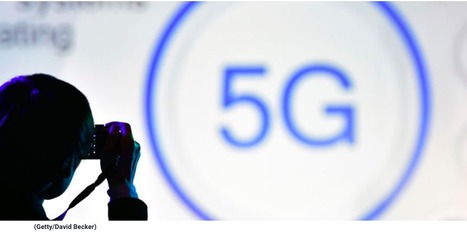






![How Big Wireless Made Us Think That Cell Phones Are Safe: The Disinformation Campaign-- and Massive Radiation Increase-- Behind The 5G Rollout // The Nation [Investigative Report] | Screen Time, Tech Safety & Harm Prevention Research | Scoop.it](https://img.scoop.it/johfZ9uvzs5Oz0bT93UNsDl72eJkfbmt4t8yenImKBVvK0kTmF0xjctABnaLJIm9)
